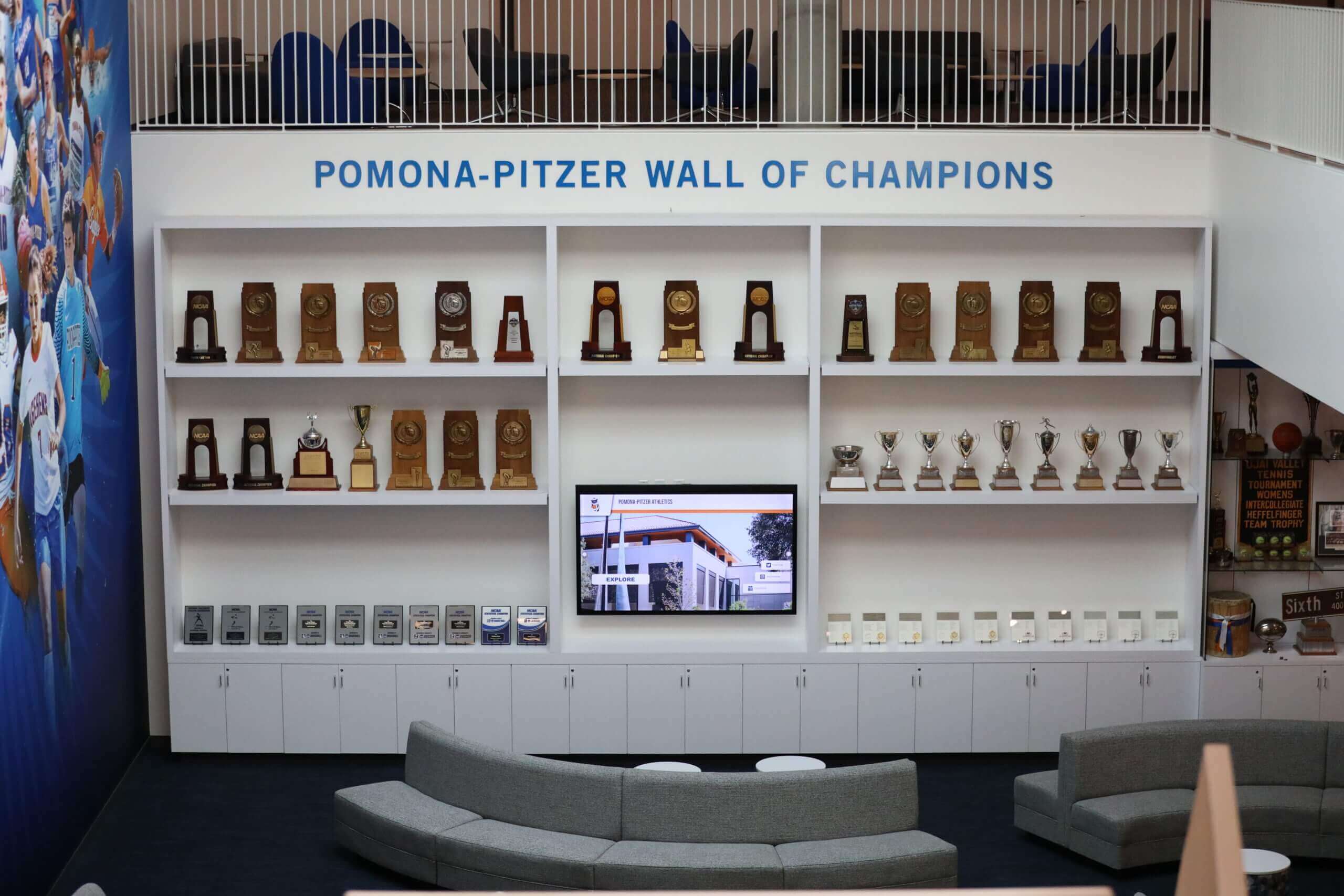Key Takeaways
Discover comprehensive strategies for trophy digital preservation in 2025. Learn scanning techniques, storage solutions, and display methods to protect achievement legacy forever.
The challenge isn’t just about running out of display space. Physical trophies deteriorate over time, becoming tarnished, damaged, or lost entirely. The information they contain—names, dates, achievements—exists nowhere else. When that single physical object disappears or becomes unreadable, the record of someone’s accomplishment vanishes forever. Digital preservation ensures these achievements survive indefinitely, accessible to anyone, anywhere, anytime.
This comprehensive guide explores everything organizations need to know about trophy digital preservation in 2025—from photography techniques and metadata strategies to storage solutions and interactive display methods. Whether you’re a school drowning in athletic trophies, a university managing century-old awards, or an organization seeking to modernize recognition programs, this guide provides practical frameworks for preserving achievement legacy through systematic digitization.
Why Trophy Digital Preservation Matters in 2025

Understanding the compelling reasons behind trophy digitization helps frame appropriate preservation strategies and secure necessary resources for implementation.
The Crisis of Physical Trophy Storage
Physical trophies create escalating space challenges that digital preservation directly addresses:
Exponential Accumulation: Active athletic programs generate 20-40 new trophies annually. Academic competitions, arts achievements, and special recognition add dozens more. Over 20 years, schools easily accumulate 1,000+ awards—far exceeding any reasonable trophy case capacity.
Space Scarcity Economics: Premium floor and wall space costs hundreds of dollars per square foot. Dedicating this valuable real estate to trophy storage prevents more productive uses like additional classrooms, study spaces, or collaborative areas.
Storage Deterioration: Trophies relegated to closets and storage rooms face suboptimal conditions. Temperature fluctuations, humidity, dust, and occasional water damage accelerate deterioration. Items stored improperly can become unrepairable within decades.
Recognition Value Loss: Trophies hidden in storage provide zero ongoing recognition value. The athletes, students, or teams who earned these awards receive no continued acknowledgment, potentially affecting alumni engagement and institutional morale.
Preservation and Accessibility Benefits
Digital preservation creates permanent, accessible records immune to physical deterioration:
Permanent Documentation: High-resolution photography captures trophies at their best condition, creating archival records that won’t fade, tarnish, or deteriorate regardless of what happens to physical items.
Enhanced Accessibility: Digital archives enable anyone to explore achievements remotely through web platforms and mobile devices. Alumni living across the country can rediscover their accomplishments. Prospective students can research program traditions during recruitment processes.
Searchable Organization: Digital systems allow instant searching by name, year, sport, achievement type, or any other criteria. Finding specific information takes seconds rather than hours of manually reviewing physical trophies.
Backup and Redundancy: Cloud-based storage with proper backup protocols ensures nothing gets lost to fire, flood, theft, or simple misplacement. Multiple copies across geographic locations protect against catastrophic loss.
According to best practices from digital archivists, properly managed digital preservation provides superior long-term protection compared to physical artifact storage when following established standards for file formats, metadata, and redundant storage systems.
Engagement and Recognition Enhancement
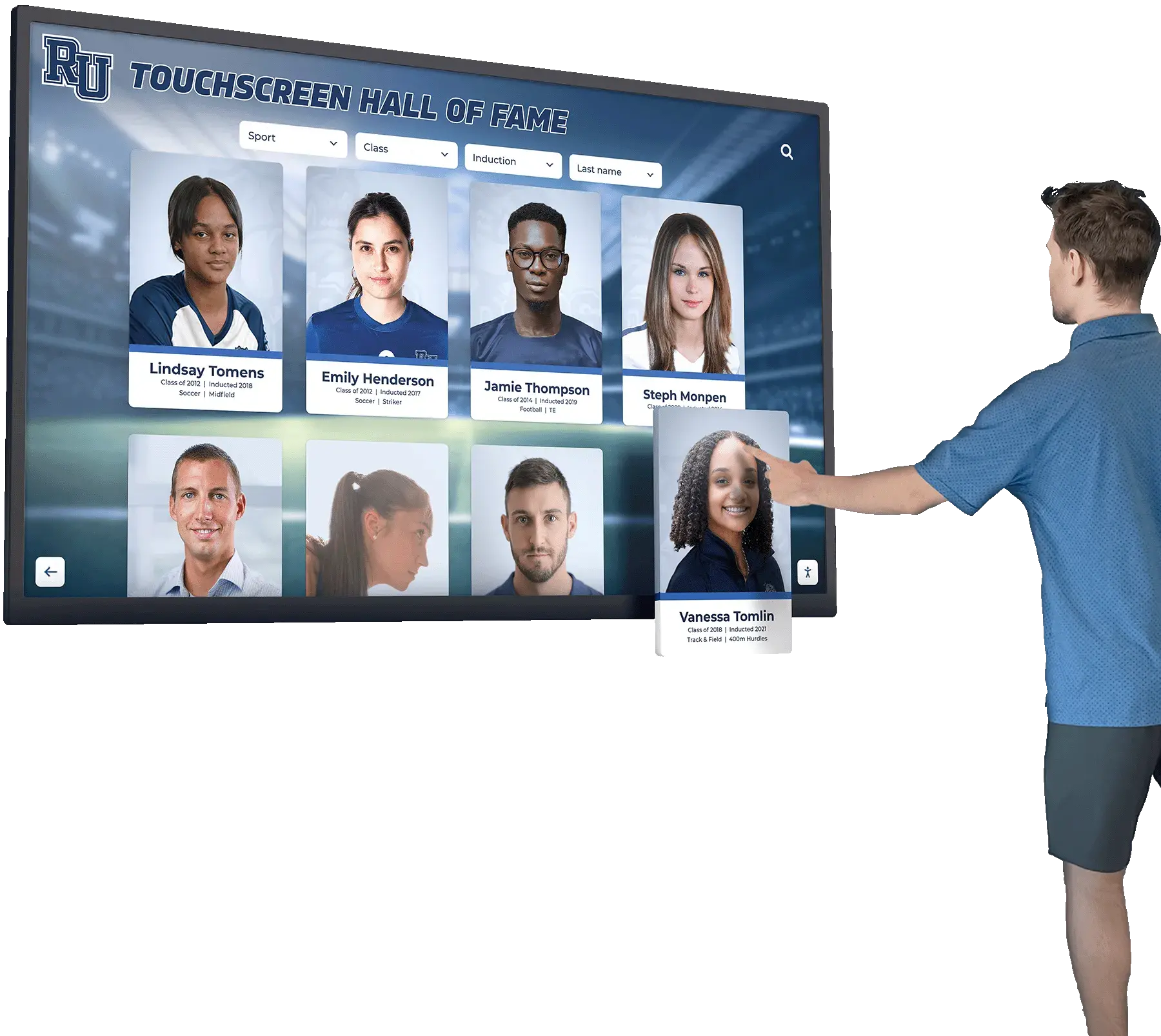
Beyond preservation, digitization enables recognition experiences impossible with physical trophies:
Rich Storytelling: Digital profiles transform simple trophies into comprehensive narratives. High-resolution photos show detail clearly. Team rosters link to individual athlete profiles. Championship game highlights bring moments to life through video. Biographical information explains where these achievers are today.
Interactive Exploration: Touchscreen displays enable visitors to search for specific athletes, browse by sport or era, filter by achievement type, and discover related accomplishments through intuitive navigation.
Social Amplification: Built-in sharing features let visitors post achievements to personal social media accounts, extending recognition reach exponentially. When athletes share their championship trophies to Instagram or Facebook, hundreds of connections see that achievement.
Continuous Updates: Digital systems accommodate new achievements instantly without requiring physical space expansion or case modification. Content management interfaces enable updates in minutes rather than hours of physical trophy arrangement.
Essential Components of Trophy Digital Preservation
Effective preservation requires systematic approaches addressing documentation, digitization, organization, storage, and access—each component serving critical roles in creating comprehensive digital archives.
High-Quality Photography and Scanning
Photography quality directly impacts preservation effectiveness and display presentation:
Equipment Requirements: While professional cameras provide maximum quality, modern smartphones (iPhone 14 or newer, comparable Android devices) suffice for most trophy documentation when using proper lighting and technique. Their convenience often outweighs modest quality differences from dedicated cameras.
Lighting Considerations: Natural diffused daylight provides optimal lighting for most photography. Position near large windows with indirect sunlight or work outdoors on overcast days. For indoor work without adequate natural light, LED light panels ($50-$200) positioned at 45-degree angles dramatically improve results while avoiding harsh shadows and glare on metallic surfaces.
Multiple Perspectives: Capture trophies from several angles:
- Front view showing full trophy design and primary engraving
- Detail close-up of all engraved text ensuring complete readability
- Three-quarter view demonstrating trophy depth and design elements
- Back view if additional recognition information appears there
- Scale reference showing trophy size relative to familiar objects for very large or small items
Resolution Standards: Shoot at highest available resolution. Minimum acceptable is 1920x1080 pixels for featured content, with 2400x1600 or higher preferred. High resolution enables zooming features in interactive displays and maintains quality in large touchscreen presentations.
Background and Staging: Use neutral white or light gray backgrounds ensuring trophies remain the focus. Position items 12-24 inches from backdrops preventing shadows. Clean trophies before photography, removing dust and fingerprints that photograph more prominently than they appear to the eye.
Comprehensive Metadata and Organization
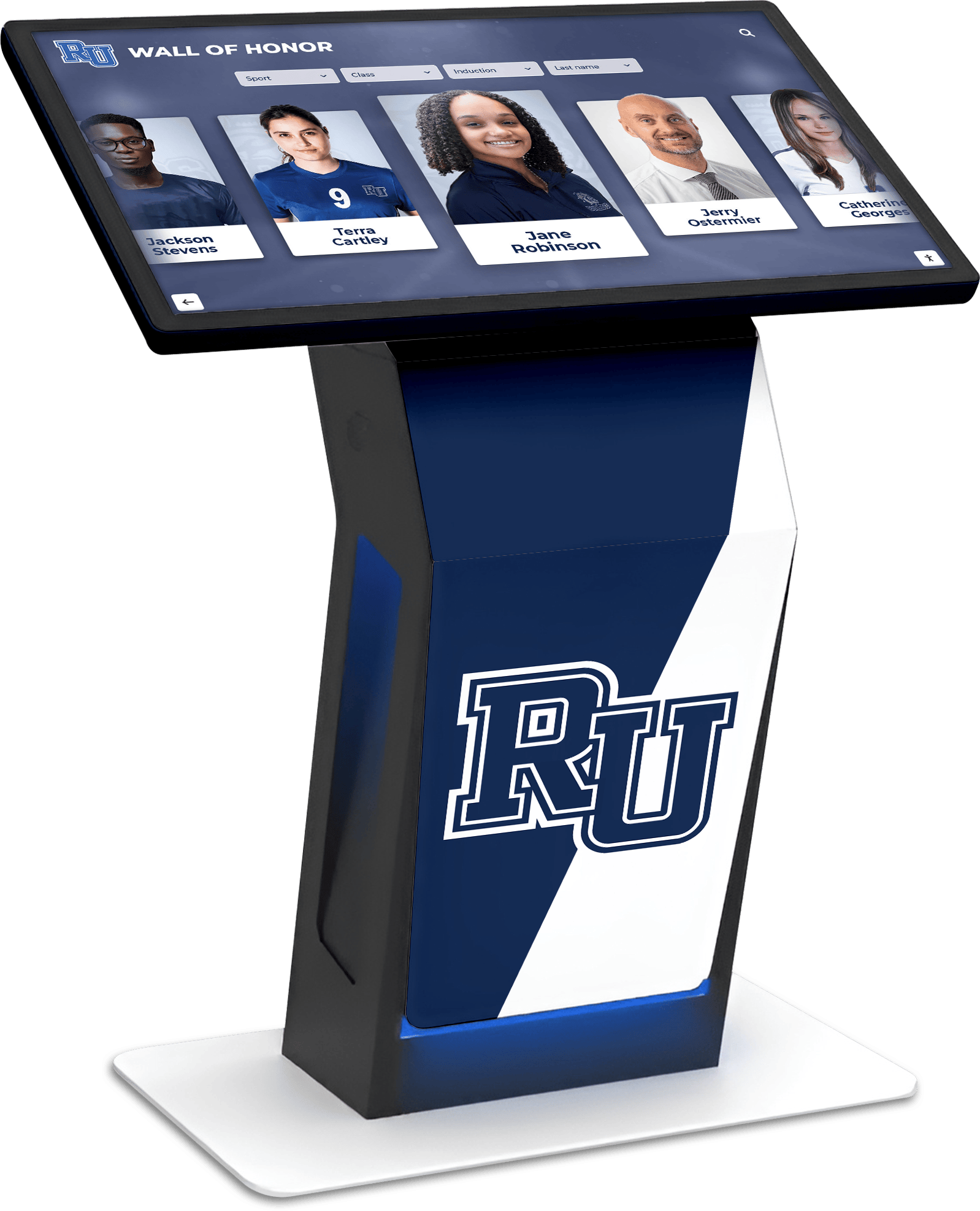
Metadata transforms scanned images into intelligent, searchable archives rather than simple photo galleries:
Essential Metadata Fields:
- Trophy type and description
- Sport, activity, or program
- Achievement level (conference, state, national, etc.)
- Year awarded (specific date when known)
- Individual names or team roster
- Coach names and roles
- Competition details and context
- Historical significance notes
- Current physical location
- Related trophies and achievements
Controlled Vocabularies: Establish consistent terminology preventing variations that fragment search results. Define standard terms for sports names, achievement types, and organizational categories. Document these vocabularies ensuring future staff maintain consistency.
Hierarchical Organization: Structure content enabling multiple navigation approaches:
- By Sport: All football trophies together, all basketball trophies together, enabling sport-specific browsing
- By Year: Chronological timelines showing achievement progression and program evolution
- By Type: Championships separate from individual awards, clarifying recognition categories
- By Significance: Hall of Fame sections highlighting most prestigious achievements
Relationship Mapping: Connect related content enabling discovery. Link individual athlete profiles to championship teams they participated in. Associate coaching profiles with all teams they led. Connect school records with championship teams that set them.
Secure Storage and Backup Systems
Digital preservation requires robust storage infrastructure protecting against data loss:
Primary Storage Solutions:
- Cloud-based platforms (Google Drive, Dropbox, OneDrive, etc.) providing anywhere access
- Local servers for organizations preferring on-premise control
- Hybrid approaches combining local speed with cloud backup redundancy
Backup Strategies following the 3-2-1 rule:
- 3 copies of all data (1 primary + 2 backups)
- 2 different media types (e.g., cloud + local drives)
- 1 off-site backup protecting against localized disasters
File Format Standards:
- Master files: TIFF format for archival preservation, providing uncompressed maximum quality
- Access copies: JPEG for web display and sharing, balancing quality with file size
- Metadata files: Sidecar files or embedded EXIF data ensuring information travels with images
Version Control: Track changes to both images and metadata over time. Document who made changes, when, and why. Maintain ability to revert to previous versions if errors occur.
Access Controls: Implement appropriate security based on content sensitivity. Public archives may offer open access, while school records require authentication and role-based permissions protecting student information.
Digitization Workflow: Step-by-Step Implementation
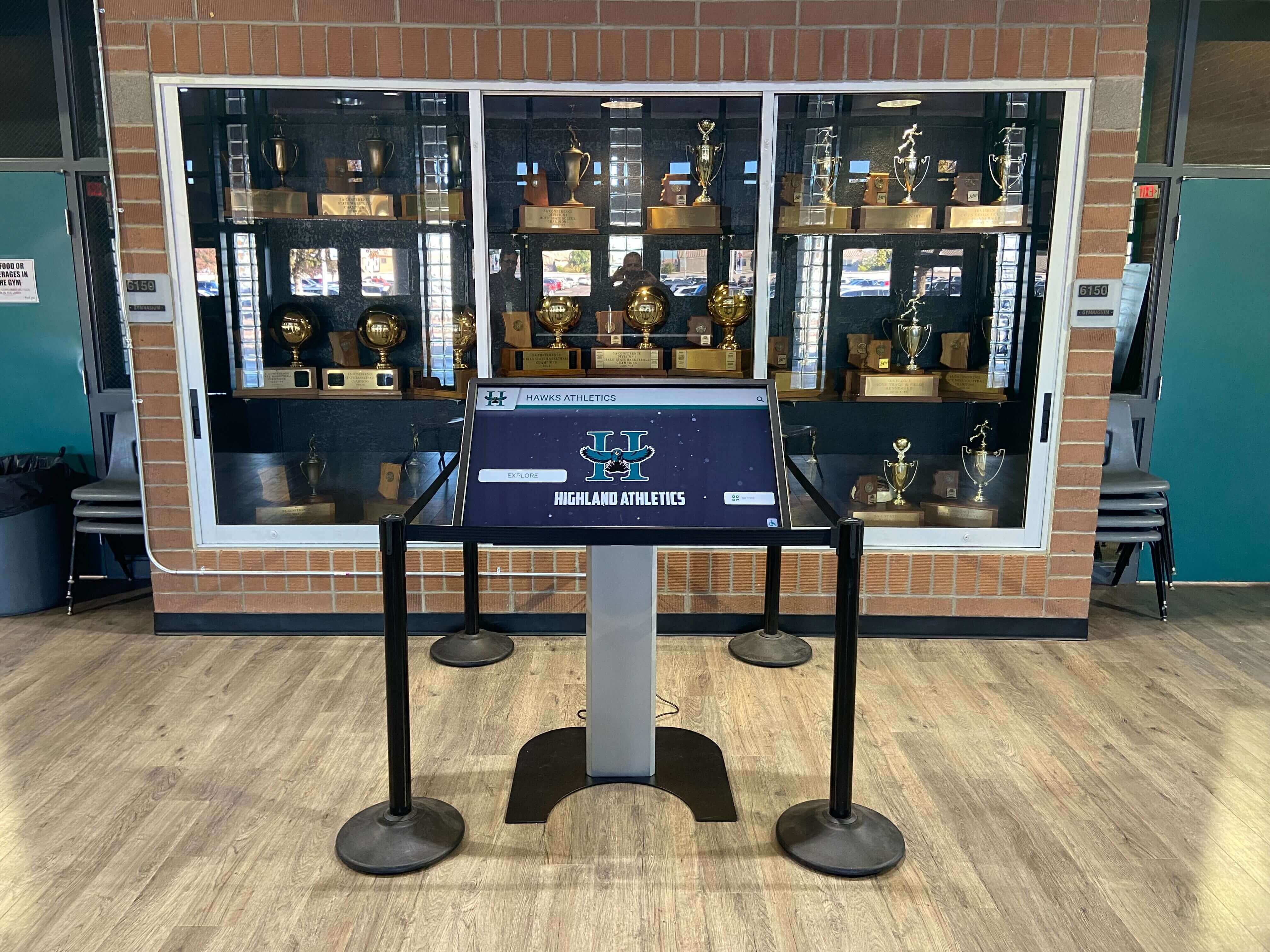
Successful digitization follows systematic processes ensuring comprehensive coverage and consistent quality across large trophy collections.
Phase 1: Inventory and Assessment
Comprehensive Cataloging: Before photographing anything, document everything you have:
- Trophy cases and current displays
- Storage room contents
- Athletic department offices
- Administrative areas
- Maintenance and facility storage
- Any off-site storage locations
Create spreadsheets tracking each item’s current location, condition, approximate date, and basic description. This inventory reveals full project scope and helps prioritize digitization efforts.
Condition Assessment: Evaluate physical state of trophies:
- Excellent condition suitable for continued display
- Good condition but showing age or minor wear
- Fair condition with significant tarnishing or damage
- Poor condition requiring conservation or documentation only
- Irreparable condition where digital preservation becomes only viable recognition option
Prioritization Matrix: Categorize trophies by importance and urgency:
Tier 1 - High Priority:
- Most significant achievements (state/national championships, major records)
- Severely deteriorating items requiring immediate documentation
- Frequently requested trophies for recognition programs
- Hall of Fame inductee awards and milestone recognition
Tier 2 - Medium Priority:
- Conference championships and regional titles
- Individual achievement awards and honors
- Recent trophies (past 20 years) in good condition
- Team awards with complete roster information available
Tier 3 - Lower Priority:
- Participation trophies without competitive significance
- Good condition recent items unlikely to deteriorate soon
- Duplicate trophies for same achievements
- Items with incomplete or uncertain attribution
Phase 2: Content Gathering and Research
Trophy digitization requires contextual information beyond what physical awards contain:
Yearbook Research: Consult yearbooks from relevant years finding:
- Team photos showing actual athletes who earned trophies
- Individual portraits for player profiles
- Season summaries providing context
- Action photos from competitions
Media Coverage: Search newspaper archives for:
- Contemporary game accounts and championship stories
- Feature articles about record-breaking performances
- Tournament results and bracket information
- Historical context placing achievements in broader perspective
Alumni Outreach: Contact former athletes and coaches gathering:
- First-person memories and perspectives
- Additional photos they may have retained
- Stories and anecdotes not captured in official records
- “Where are they now” updates for biographical profiles
Statistical Verification: Confirm achievement details through:
- Athletic department record books
- State athletic association archives
- MaxPreps or similar statistical databases for recent years
- Conference and tournament results documentation
Phase 3: Photography and Digitization
Execute systematic photography following established standards:
Setup Consistency: Create dedicated photography station ensuring:
- Consistent lighting from session to session
- Standard background and positioning
- Calibrated camera settings
- Stable tripod preventing camera shake
- Reference color charts enabling color correction
Photography Checklist for each trophy:
- Overall trophy photo from primary viewing angle
- Close-up of engraved text ensuring complete readability
- Additional angles showing trophy design and construction
- Detail shots of decorative elements or unique features
- Scale reference (ruler or familiar object) establishing size
Quality Control: Review every image before moving to next trophy:
- Sharp focus throughout, especially on text
- Proper exposure without blown highlights or blocked shadows
- Even lighting without harsh shadows or glare
- Complete capture of all engraved information
- Adequate resolution for intended display purposes
Supplementary Materials: Beyond trophies themselves, digitize:
- Team photos and individual portraits
- Championship banners and pennants
- Newspaper clippings and media coverage
- Program books and rosters
- Certificates and official recognition documents
Phase 4: Content Development and Metadata Application
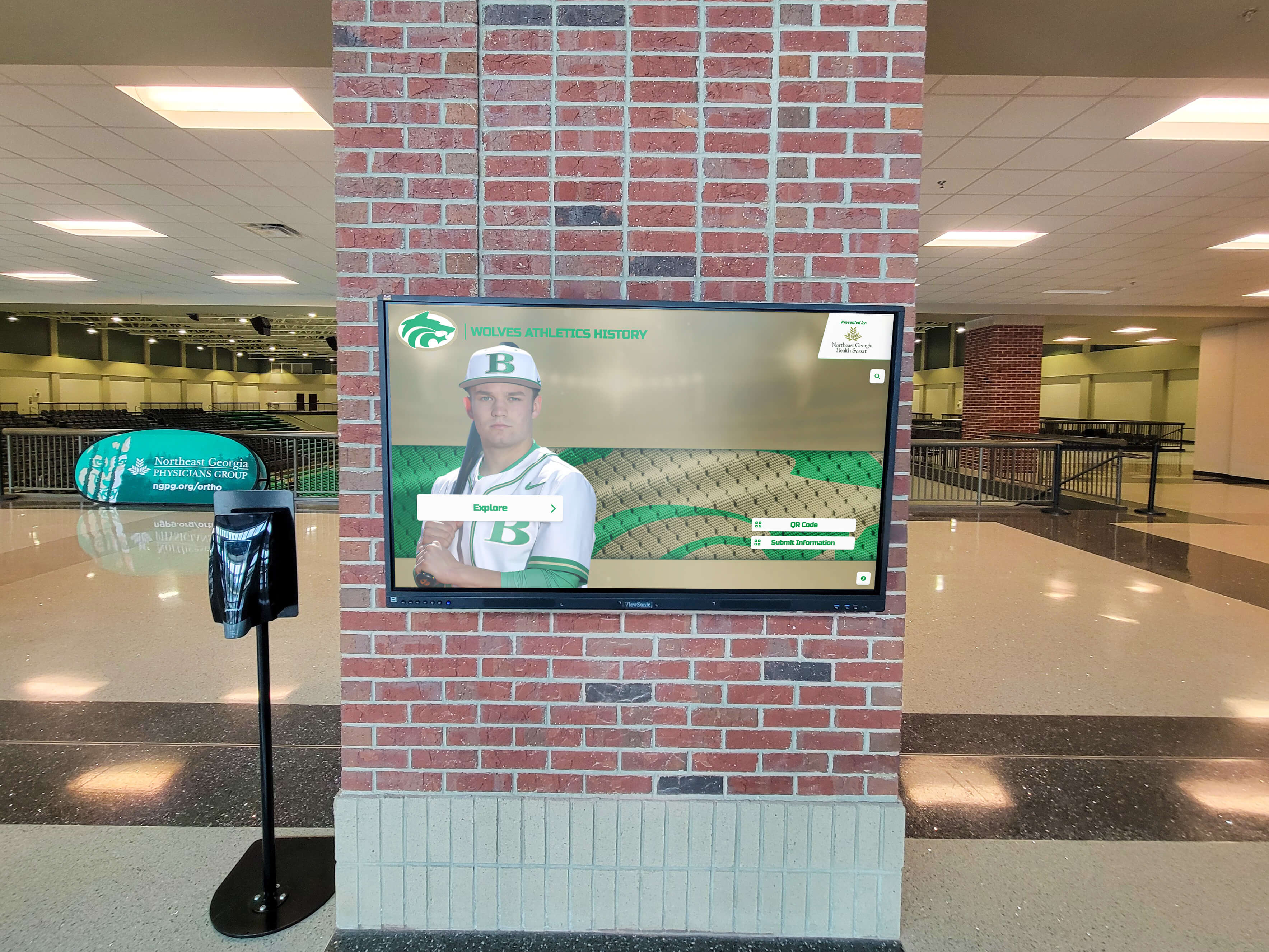
Transform raw images into rich profiles:
Profile Structure Templates: Develop consistent formats adapted for different trophy types:
Championship Trophy Profile:
- Sport and season year
- Championship level (conference, state, national)
- Season record and significant statistics
- Tournament path or playoff results
- Complete team roster with graduation years
- Coaching staff recognition
- Highlights and memorable moments
- Historical significance (first championship, streak, breakthrough)
- Related achievements and subsequent success
Individual Achievement Profile:
- Recipient name and sport
- Award name and significance
- Year received and competition level
- Performance statistics or highlights
- Other achievements during career
- Team achievements during competitive years
- Biographical information (graduation year, college, career updates)
- Records held or distinctions earned
Metadata Application: Apply structured data enabling search and filtering:
- Primary category and subcategories
- All relevant names (athletes, coaches, contributors)
- Dates (year, season, specific dates when known)
- Achievement type and level
- Keywords describing achievement circumstances
- Relationship tags linking related content
Quality Assurance: Review completed profiles ensuring:
- Factual accuracy of all information
- Completeness of required fields
- Consistent application of naming conventions
- Proper relationship linking
- Appropriate image quality and selection
Storage Solutions and Digital Asset Management
Choosing appropriate platforms for long-term storage and access significantly impacts preservation success and operational efficiency.
Cloud-Based Preservation Platforms
Google Workspace for Education: Many schools already use Google, making Drive natural choice:
- Unlimited storage (in education licenses)
- Familiar interface requiring minimal training
- Collaborative features enabling multiple contributors
- Integration with school systems and authentication
- Strong search capabilities across documents
- Mobile access from any device
- Automatic version history
Microsoft OneDrive/SharePoint: Alternative for Microsoft 365 schools:
- Similar benefits to Google Drive
- Integration with Office applications
- Enterprise-grade security and compliance features
- Configurable retention policies
- Workflow automation capabilities
- Hybrid deployment options
Purpose-Built Digital Asset Management: Specialized platforms designed specifically for media libraries:
- Rocket Alumni Solutions offers education-focused asset management
- Advanced metadata capabilities beyond basic cloud storage
- Built-in relationship mapping between assets
- Permission systems controlling access and usage
- Integration with recognition display systems
- Templates and workflows specific to trophy digitization
Integrated Recognition and Display Platforms
The most powerful implementations connect preservation with recognition displays through unified platforms:
Single-Platform Advantages:
- Content flows automatically from management to displays
- No manual file transfers or format conversions required
- Guaranteed consistency across all presentation locations
- Unified authentication and access control
- Consolidated licensing and support reducing complexity
- Real-time updates instantly visible everywhere
Rocket Alumni Solutions provides this integrated approach specifically for educational recognition:
- Centralized digital asset management for all recognition content
- Direct integration with interactive touchscreen displays
- Automatic content synchronization across installations
- Template systems ensuring consistent presentation quality
- Mobile-responsive web access extending reach beyond physical displays
- Purpose-built for schools’ trophy and achievement documentation needs
This integration eliminates common challenges organizations face when connecting separate storage and display systems—format incompatibilities, manual update processes, version confusion, and technical complexity that requires IT expertise for routine updates.
Creating Interactive Recognition Experiences
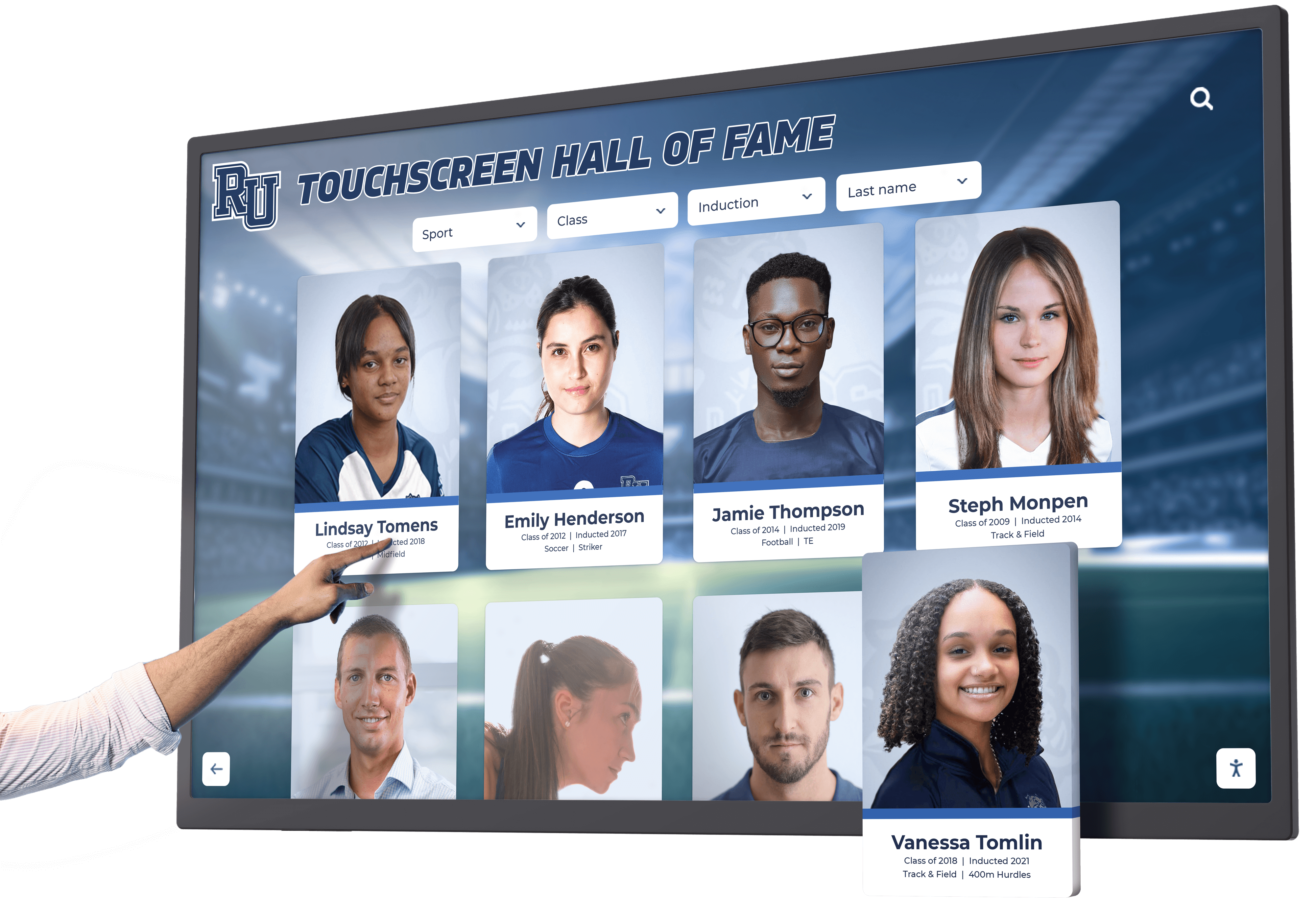
Digital preservation enables recognition experiences far beyond what physical trophy cases provide.
Touchscreen Display Implementation
Interactive displays transform archived content into engaging explorations:
Display Hardware: Commercial-grade touchscreens (43"-75") provide:
- Intuitive smartphone-like interaction
- High-resolution presentation of trophy photos
- Continuous operation reliability (16-18 hours daily)
- Professional appearance appropriate for institutional settings
- Multiple mounting options (wall-mounted, freestanding kiosks, custom enclosures)
Interactive Features engaging visitors:
- Powerful Search: Find specific athletes, teams, years, or sports instantly
- Smart Filtering: Browse by decade, achievement type, sport, or recognition level
- Related Content: Discover connected achievements automatically
- Detailed Profiles: Explore comprehensive information beyond simple trophy labels
- Social Sharing: Post accomplishments to personal social media extending recognition reach
- Mobile Access: QR codes enabling exploration on personal smartphones
Content Presentation: Well-designed interfaces feature:
- Clear navigation enabling both browsing and targeted searching
- High-quality trophy images with zoom capabilities showing detail
- Biographical information and contextual narratives
- Video highlights when available
- Timeline views showing achievement progression
- Related content suggestions encouraging extended exploration
Web-Based Access and Remote Engagement
Extending digital archives beyond physical displays multiplies accessibility and engagement:
Alumni Connections: Remote access enables:
- Graduates exploring their achievements from anywhere globally
- Sharing accomplishments with family and friends
- Rediscovering forgotten teammates and memories
- Contributing updates and contemporary photos
- Maintaining ongoing connection with institutional history
Recruitment Support: Prospective students and families:
- Research program traditions and excellence
- Understand competitive expectations and achievement standards
- Explore facility recognition and institutional pride
- Connect with accomplished alumni from their communities
Community Engagement: Local community members:
- Research local history and connections
- Discover relatives’ or friends’ achievements
- Access materials for historical research projects
- Appreciate institutional heritage and contributions
Hybrid Physical and Digital Recognition
Many organizations discover optimal approaches combine physical and digital elements:
Curated Physical Displays: Maintain trophy cases showcasing:
- Most prestigious championships (state/national titles)
- Historic milestone achievements
- Retired jerseys and hall of fame inductees
- Rotating exhibitions changing quarterly or annually
Comprehensive Digital Archives: Provide complete accessibility to:
- All trophies regardless of display space limitations
- Historical achievements from all eras
- Individual awards and lesser-known accomplishments
- Complete rosters and biographical information
Connected Experiences: Integrate physical and digital through:
- QR codes near physical trophies linking to comprehensive digital profiles
- Digital displays adjacent to trophy cases showing related video content
- Mobile apps overlaying additional information when viewing physical awards
- Synchronized rotations where digital features match current physical exhibitions
Managing Physical Trophies After Digitization
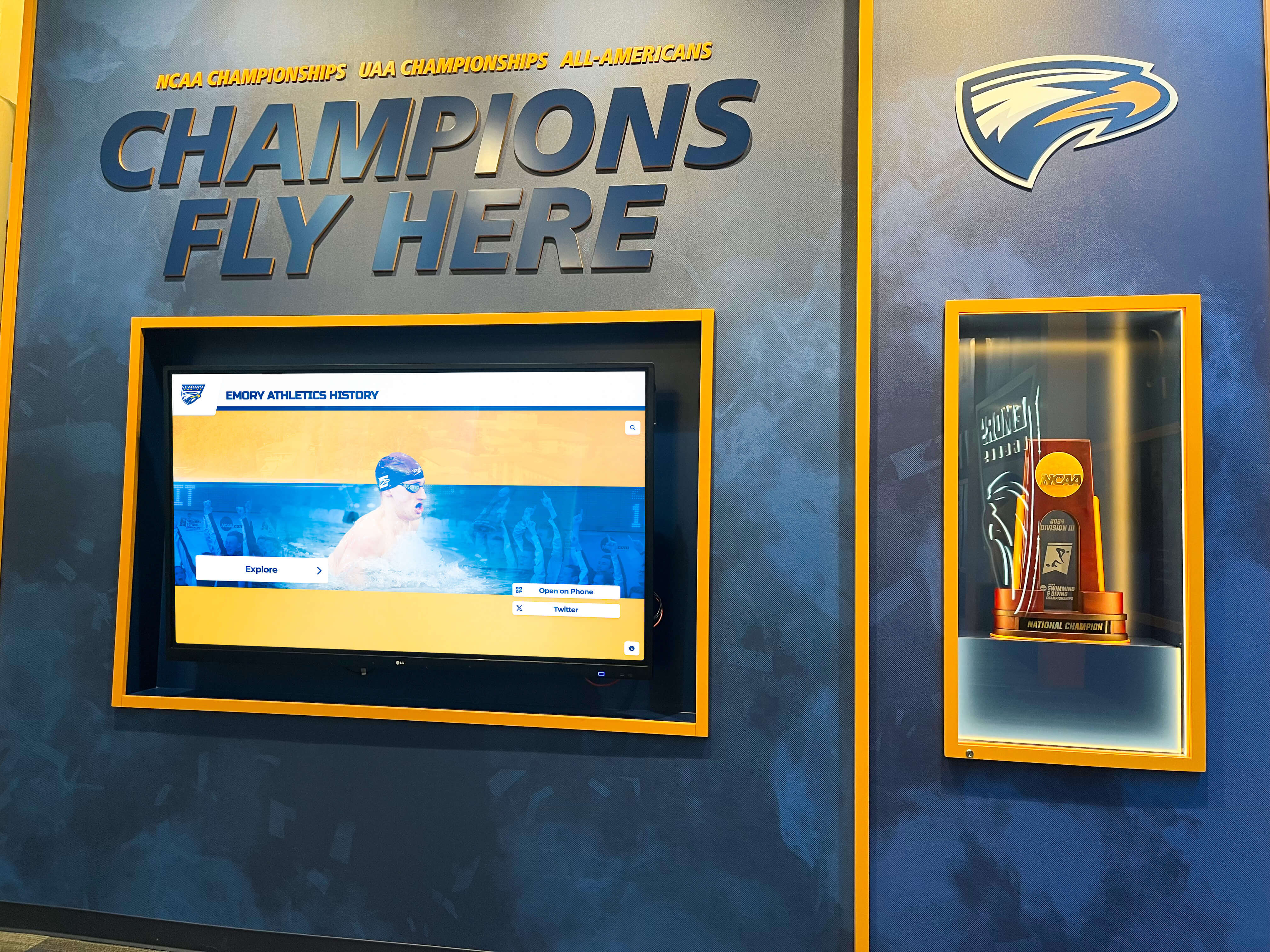
Digital preservation doesn’t necessarily mean disposing of physical trophies, but it does enable flexible approaches:
Archival Storage Approaches
Professional Archiving: For historically significant trophies:
- Climate-controlled storage maintaining stable temperature and humidity
- Acid-free materials preventing deterioration
- Proper support preventing structural damage
- Periodic condition monitoring
- Documentation of storage locations and methods
- Insurance coverage for valuable items
Organized Storage: For general trophy collections:
- Systematic organization by sport, year, or achievement type
- Clear labeling enabling location of specific items when needed
- Protective wrapping preventing damage
- Accessible arrangement allowing retrieval without disturbing other items
- Inventory systems tracking what exists and where it’s stored
Alumni Trophy Return Programs
Many organizations offer trophies to individuals who earned them:
Benefits of Return Programs:
- Alumni appreciate receiving tangible mementos from competitive years
- Reduces institutional storage requirements
- Creates positive engagement opportunities
- Honors achievement by returning awards to recipients
- Maintains comprehensive digital documentation regardless of physical location
Implementation Considerations:
- Contact information for reaching former athletes
- Clear policies about which trophies qualify (typically excluding major championships retained institutionally)
- Shipping logistics and cost responsibilities
- Acknowledgment that digital records remain accessible institutionally
- Opportunities for recipients to contribute additional photos or stories
Responsible Disposal Options
For standard trophies without particular historical significance:
Trophy Recycling Services: Professional services that:
- Separate metal, plastic, marble, and wood components
- Recycle materials responsibly
- Provide certificates of destruction when appropriate
- Minimize landfill waste
- Handle bulk quantities efficiently
Donation Programs: Some organizations accept:
- Plaques with removable nameplates for reuse
- Trophies appropriate for youth participation awards
- Materials suitable for arts and crafts projects
- Metal components for scrap recycling value
Repurposing Initiatives: Creative approaches include:
- Artistic installations using old trophies
- Educational displays about award evolution
- Fundraising through creative trophy sales
- Community projects incorporating historical items
Measuring Success and Demonstrating Value
Comprehensive evaluation demonstrates preservation program effectiveness and guides continuous improvement.
Quantitative Metrics
Preservation Progress:
- Number of trophies digitized
- Percentage of complete trophy collection documented
- Volume of supplementary materials preserved (photos, clippings, etc.)
- Metadata completion rates
- Storage space reclaimed from physical trophy removal
Usage Statistics (for interactive displays):
- Total visitor interactions per month
- Average session duration
- Search queries performed
- Most-viewed achievements
- Return visitor rates
- Social media shares
- Web platform visitors and page views
Efficiency Improvements:
- Time required to locate specific achievement information (before vs. after digitization)
- Requests fulfilled through digital access vs. requiring physical trophy access
- Staff hours spent on trophy-related activities
Qualitative Outcomes
Stakeholder Feedback gathered through:
- Alumni surveys about digital archive accessibility and usefulness
- Student input about interactive display engagement
- Coach perspectives on recognition program improvements
- Administrator observations about community responses
- Visitor comments during tours and events
Recognition Program Enhancement:
- Expanded achievement visibility beyond space-limited physical cases
- More equitable recognition across all sports and programs
- Improved storytelling through rich multimedia content
- Stronger alumni connections through accessible historical records
- Enhanced recruitment support through comprehensive program documentation
Preservation Confidence:
- Assurance that achievements won’t be lost to deterioration, damage, or disposal
- Backup redundancy protecting against catastrophic loss
- Permanent documentation regardless of physical trophy fate
- Searchable organization preventing information loss
Getting Started: Implementation Roadmap
Organizations ready to implement trophy digital preservation should follow systematic approaches ensuring successful outcomes.
Months 1-2: Planning and Preparation
Project Team Formation:
- Project manager overseeing overall implementation
- Subject matter experts (athletic directors, archivists)
- Technical staff handling systems and infrastructure
- Content specialists for research and documentation
- Stakeholder representatives providing input and feedback
Resource Assessment:
- Available budget for equipment, software, and services
- Staff time allocation for project activities
- Existing equipment suitable for digitization (cameras, scanners, computers)
- Storage and network infrastructure capabilities
- Vendor services needed vs. internal capabilities
Scope Definition:
- Trophy collection size and complexity
- Prioritization of content tiers
- Timeline expectations and milestones
- Success criteria and evaluation methods
- Integration requirements with existing systems
Months 2-4: Digitization Execution
Photography Setup: Establish consistent procedures:
- Dedicated photography station with controlled lighting
- Standard backgrounds and positioning
- Camera settings documentation
- Quality control checklists
- File naming and organization protocols
Systematic Processing: Work through prioritized tiers:
- Schedule regular photography sessions (2-4 hours weekly typically productive)
- Batch similar trophy types together for efficiency
- Review quality immediately after photography sessions
- Apply basic metadata during or immediately after photography
- Store master files in organized directory structures
Research Integration: Gather contextual information:
- Yearbook consultation schedules
- Newspaper archive searches
- Alumni outreach campaigns
- Statistical verification processes
- Content compilation procedures
Months 4-6: Platform Implementation and Content Development
Technology Deployment:
- Cloud storage or digital asset management setup
- Authentication and access control configuration
- Display hardware procurement and installation (if implementing interactive displays)
- Integration with existing school systems
- Training preparation materials development
Content Enhancement:
- Write achievement profiles using established templates
- Develop biographical information for individuals
- Create team rosters and coaching profiles
- Link related achievements building relationships
- Enhance metadata beyond basic fields captured during photography
Quality Assurance:
- Systematic review of completed profiles
- Factual accuracy verification
- Consistency checks across similar content
- User acceptance testing with representative stakeholders
- Refinement based on feedback
Months 6-8: Launch and Promotion
Soft Launch period for testing:
- Limited release to internal users
- Bug identification and resolution
- Content refinement based on real usage
- Training adjustments addressing observed challenges
- Final preparations for public launch
Grand Opening celebrating achievement:
- Event during high-attendance occasion (homecoming, reunion, etc.)
- Demonstrations highlighting interactive features
- Alumni engagement opportunities
- Media coverage generating awareness
- Social media promotion extending reach
Ongoing Management establishing sustainability:
- Content update procedures for new achievements
- Responsibility assignments for maintenance
- Regular evaluation schedules
- Continuous improvement processes
- Community contribution mechanisms
Future Trends in Trophy Digital Preservation
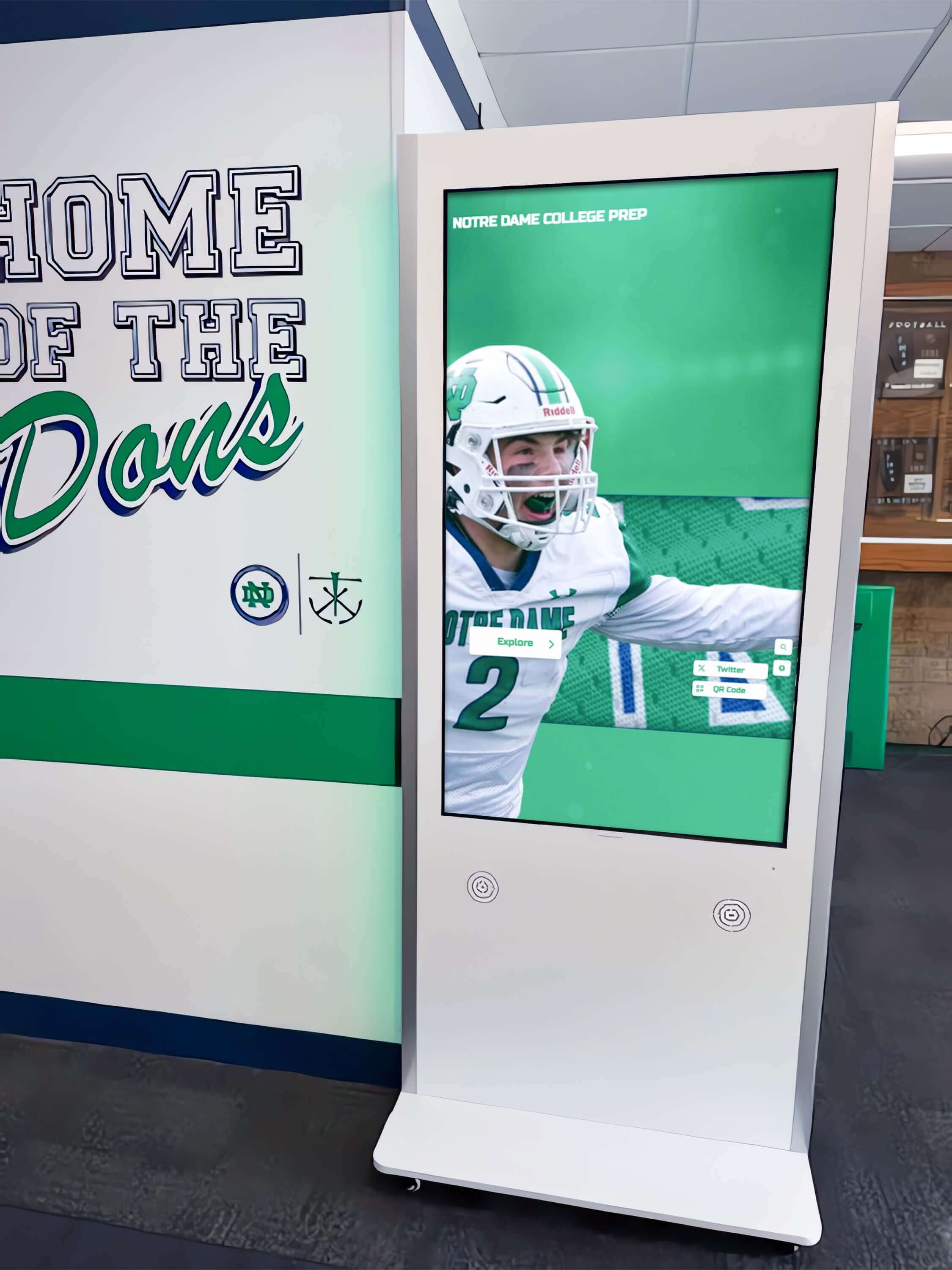
Technology evolution continues creating new preservation and presentation possibilities.
Artificial Intelligence Applications
Automated Metadata Generation: AI systems increasingly capable of:
- Text extraction from trophy engravings through advanced OCR
- Automatic tagging and categorization
- Biographical information enrichment from web sources
- Relationship detection between related achievements
- Quality assessment flagging images requiring reshooting
Enhanced Search: Natural language processing enabling:
- Conversational queries (“Show me all basketball championships from the 1990s”)
- Semantic understanding beyond exact keyword matching
- Automatic query refinement suggestions
- Personalized recommendations based on viewing history
Augmented and Virtual Reality
AR Trophy Enhancement: Visitors pointing smartphones at physical or digital trophy displays seeing:
- Overlaid video highlights of championship moments
- 3D animated statistics and performance data
- Historical photos and contemporary updates appearing in viewfinder
- Interactive timeline showing related achievements
- Links to extended biographical content
VR Trophy Rooms: Immersive virtual environments where remote visitors:
- Walk through recreated trophy displays
- Examine trophies from all angles in 3D space
- Access comprehensive information through virtual interaction
- Experience presence despite geographic separation
Blockchain and Permanent Records
Distributed Preservation: Blockchain technology potentially offering:
- Permanent, immutable achievement records
- Verification preventing fraudulent claims
- Decentralized storage enhancing preservation permanence
- Credential verification for employment or further education
- Community-contributed content with provenance tracking
Conclusion: Preserving Excellence for Generations
Trophy digital preservation represents more than solving storage problems or preventing deterioration—it constitutes fundamental commitment to honoring achievement, preserving institutional memory, and ensuring decades of excellence remain accessible and valued indefinitely.
Physical trophies served important purposes for generations, providing tangible symbols of accomplishment and physical representations of dedication and success. But when space limitations force most trophies into storage, when deterioration makes engravings unreadable, when only a fraction of achievements receive ongoing recognition, the full value of these awards disappears.
Digital preservation ensures every trophy tells its story forever. High-resolution photography captures awards at their best. Comprehensive profiles provide context that physical engravings cannot convey. Searchable databases make specific achievements instantly discoverable. Interactive displays create engaging experiences that passive trophy cases never achieve. Cloud storage with proper backups guarantees nothing gets lost to fire, flood, damage, or simple misplacement.
The process requires commitment—time investment for photography and research, financial resources for systems and storage, sustained effort maintaining quality and adding new content. However, organizations consistently report that digitization delivers strong returns through improved engagement, enhanced preservation, operational efficiency, and stakeholder satisfaction.
Whether launching initial planning, executing active digitization, or managing established digital archives, remember that success depends on treating this work as ongoing organizational commitment rather than finite project. Excellence compounds over time as comprehensive content libraries grow, community engagement deepens, and recognition systems become integral to institutional culture rather than isolated displays.
Ready to preserve your organization’s achievement legacy through systematic digitization? Solutions like Rocket Alumni Solutions provide purpose-built platforms, implementation expertise, and ongoing support specifically designed for trophy and achievement digitization, combining intuitive content management with interactive recognition displays that honor the past while serving current and future community members.
Your trophies represent stories of dedication, perseverance, and triumph. Digital preservation ensures these stories remain accessible, engaging, and valued forever—transforming physical awards collecting dust into living legacies inspiring generations to come.
